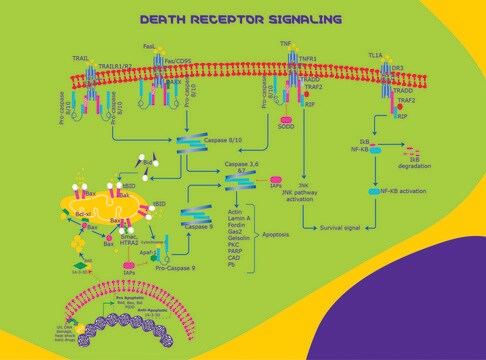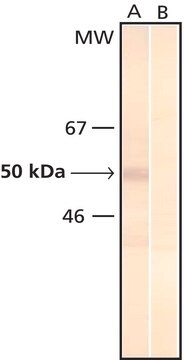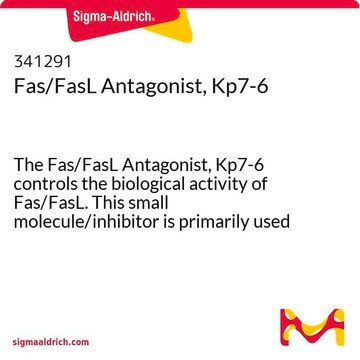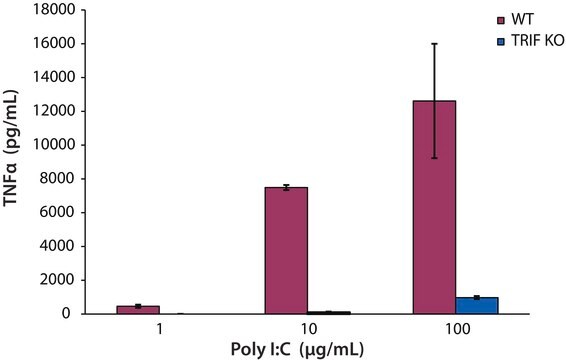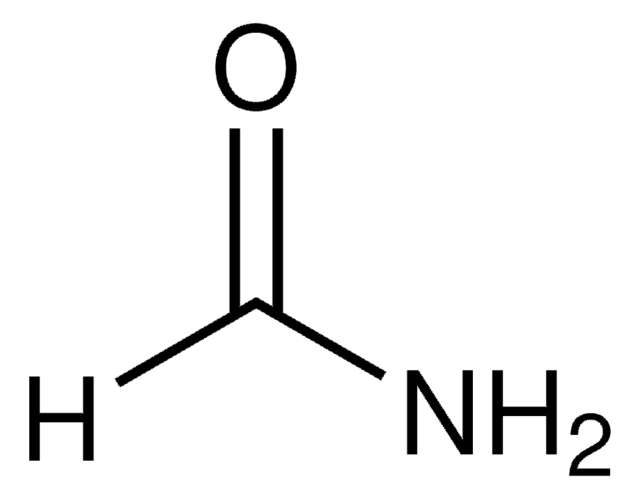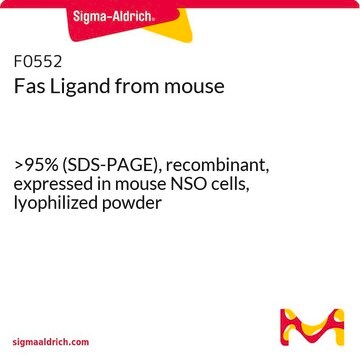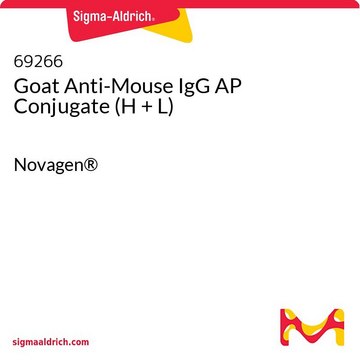F0427
Fas Ligand human
>95% (SDS-PAGE), recombinant, expressed in CHO cells, lyophilized powder
Synonym(s):
FasL
Sign Into View Organizational & Contract Pricing
All Photos(1)
About This Item
Recommended Products
recombinant
expressed in CHO cells
Quality Level
assay
>95% (SDS-PAGE)
form
lyophilized powder
mol wt
monomer calculated mol wt ~18 kDa
26-28 kDa by SDS-PAGE
impurities
endotoxin, tested
UniProt accession no.
storage temp.
−20°C
Gene Information
human ... FASLG(356)
Related Categories
General description
FASLG (Fas ligand) acts as a ligand for Fas receptor, and is a major protein involved in programmed cell death, apoptosis. Soluble Fas (sFAS) is usually detected in plasma prior to apoptosis.
Application
Fas Ligand (FASLG) human has been used for-
- the study of FASLG stimulation in luteal cells obtained from mid-corpus luteum (CL) and
- the study of apoptosis induction and intracellular caspase-3 assay in human cells.
Biochem/physiol Actions
FASLG (Fas ligand) and Fas receptor constitute the basic elements in apoptosis. Interaction of FASLG with Fas receptor leads to activation of caspase-8. This caspase in turn leads to activation of effector caspases such as caspase-3, -6 and -7. This cascade results in the hydrolysis of nuclear and cytoplasmic components. Expression of FASLG is induced by nuclear factor-κB (NFκB). NFκB/FASLG pathway facilitates the suppression of p,p′-DDT (dichlorodiphenoxytrichloroethane)-induced cell toxicity by vitamin C and E. In CD4+ T cells, this protein is expressed on stimulus by T-cell receptor (TCR), both during normal and pathological conditions, such as alcohol exposure.
Fas ligand, a protein belonging to the tumor necrosis factor (TNF) family of cytokines, induces apoptosis in cells expressing the cell membrane receptor Fas (CD95/Apo-1).
Protein belonging to the tumor necrosis factor (TNF) family of cytokines; induces apoptosis in cells expressing the cell membrane receptor Fas (CD95/Apo-1).
Other Notes
Human Fas Ligand, N-terminal 6X histidine-tagged, encodes amino acids 134-281.
Physical form
Lyophilized from a 0.2 μm filtered solution in phosphate buffered saline containing 0.5 mg bovine serum albumin.
Analysis Note
Measured by its ability to induce apoptosis in Jurkat cells.
signalword
Warning
hcodes
pcodes
Hazard Classifications
Eye Irrit. 2 - Skin Irrit. 2
Storage Class
11 - Combustible Solids
wgk_germany
WGK 3
flash_point_f
Not applicable
flash_point_c
Not applicable
Choose from one of the most recent versions:
Already Own This Product?
Find documentation for the products that you have recently purchased in the Document Library.
Malavika S Giri et al.
Journal of immunology (Baltimore, Md. : 1950), 182(7), 4459-4470 (2009-03-21)
Mechanisms that may allow circulating monocytes to persist as CD4 T cells diminish in HIV-1 infection have not been investigated. We have characterized steady-state gene expression signatures in circulating monocytes from HIV-infected subjects and have identified a stable antiapoptosis gene
Xiaoting Jin et al.
PloS one, 9(12), e113257-e113257 (2014-12-03)
Dichlorodiphenoxytrichloroethane (DDT) is a known persistent organic pollutant and liver damage toxicant. However, there has been little emphasis on the mechanism underlying liver damage toxicity of DDT and the relevant effective inhibitors. Hence, the present study was conducted to explore
Aleksander Szymanowski et al.
Atherosclerosis, 233(2), 616-622 (2014-02-19)
Apoptosis of natural killer (NK) cells is increased in patients with coronary artery disease (CAD) and may explain why NK cell levels are altered in these patients. Soluble forms of Fas and Fas ligand (L) are considered as markers of
Antonio M Galvao et al.
Biology of reproduction, 83(6), 901-908 (2010-08-20)
Proapoptotic factor Fas ligand (FASL) and its cell surface receptor FAS are tumor necrosis factor superfamily members that trigger apoptosis in different cell types. However, their influence on luteal steroidogenesis is not clearly understood. The aim of the present work
Intracellular bacteria engage a STING-TBK1-MVB12b pathway to enable paracrine cGAS-STING signalling.
Ramya Nandakumar et al.
Nature microbiology, 4(4), 701-713 (2019-02-26)
The innate immune system is crucial for eventual control of infections, but may also contribute to pathology. Listeria monocytogenes is an intracellular Gram-positive bacteria and a major cause of food-borne disease. However, important knowledge on the interactions between L. monocytogenes
Our team of scientists has experience in all areas of research including Life Science, Material Science, Chemical Synthesis, Chromatography, Analytical and many others.
Contact Technical Service